-
Paper Information
- Paper Submission
-
Journal Information
- About This Journal
- Editorial Board
- Current Issue
- Archive
- Author Guidelines
- Contact Us
International Journal of Composite Materials
p-ISSN: 2166-479X e-ISSN: 2166-4919
2015; 5(4): 71-78
doi:10.5923/j.cmaterials.20150504.01
Mechanical Properties of Plied Cotton Fabric-Coated Unsaturated Polyester Composites: Effects of Alkali Treatments
E. O. Achukwu, B. M. Dauda, U. S. Ishiaku
Department of Textile Science and Technology, Ahmadu Bello University, Zaria, Nigeria
Correspondence to: E. O. Achukwu, Department of Textile Science and Technology, Ahmadu Bello University, Zaria, Nigeria.
| Email: |  |
Copyright © 2015 Scientific & Academic Publishing. All Rights Reserved.
This paper presents an experimental investigation on the mechanical properties of cotton fabric/polyester composites. Plied yarns (4-plies) of known count were woven and knitted into fabrics of different architectures. The cotton fabrics were subjected to chemical modifications using sodium hydroxide and its influence on some mechanical properties were analyzed. The fabrics were coated with unsaturated polyester resin as matrix. The tensile and flexural properties, impact strength and hardness of the textile composites were studied. Result indicated that alkali treatment improved the tensile strength and breaking elongation of the fabrics. The mechanical properties were found to depend on the fabric architecture; plying and fabrication conferred significant reinforcement on the composites for the different mechanical properties tested, which is an indication that woven and knitted cotton fabrics can function as reinforcement in textile composites. Increase in number of fabric layers brought about a corresponding increase in mechanical properties. Morphological studies showed that composites with treated fabrics exhibited better interfacial bonding between the matrix and reinforcement compared to other combinations as evidenced by less cracking of the matrix before fracture.
Keywords: Fabrics, Mechanical properties, Plied yarn, Surface treatment, Textile composites
Cite this paper: E. O. Achukwu, B. M. Dauda, U. S. Ishiaku, Mechanical Properties of Plied Cotton Fabric-Coated Unsaturated Polyester Composites: Effects of Alkali Treatments, International Journal of Composite Materials, Vol. 5 No. 4, 2015, pp. 71-78. doi: 10.5923/j.cmaterials.20150504.01.
Article Outline
1. Introduction
- Finding replacements for synthetic fibers such as glass, carbon have been in the front burner over the years. The main impetus in pursuing the use of natural fiber reinforced polymer composites instead of synthetic fiber reinforced polymer composites is the ecological benefit due to the problem associated with their disposal [1]. Among the natural fibers, cotton could be regarded as one of the most popular fibers used in several applications varying from common fabrics to composites [2-5]. Others include the hybridization of cotton with other natural fibers [6-8]. Works on the coating of polyester resins with improved mechanical properties have also been reported [9]. Composite panels reinforced with cotton fibers to examine the mechanical properties of such panels for use in secondary structural members such as wall or door systems was developed by Raftoyiannis [10]. The results from the study showed that the structural performance of cotton fiber composites is satisfactory for structural parts with low requirements, such as wall panels or doors. Chaudhary and Gohil [11] also presented results from experimental work on Cotton Polyester Composite (CPC) made from polyester resin reinforced with cotton fibers. The results from their study revealed that the structural performance of cotton fiber composites was satisfactory and may be used for structural applications. Rajpar et al., [12] examined the effect of the cotton fiber on mechanical properties of lower structural applications when added with the polyester resin. Relative effect of the cotton as reinforcing agent was examined and they observed that developed composite specimen possessed significant improvement in mechanical properties; tensile strength was improved as 19.78% and modulus of elasticity was increased up to 24.81%.A plied yarn (also known as ply or folded yarn) is composed of two or more single yarns twisted together. Two-ply yarn, for example is composed of two single strands of yarn and three-ply yarn is compose of three single strands. Plied yarns have been found to induce normal forces between fibers and this increasing inter-fiber friction leads to improved strength of the resultant plied yarn. Magdi et al. [13] when plying 90/1 Ne compact combed yarn, found that good yarn quality at 16% noil percentage can be obtained, which may be due to the fact that twisting two yarns together improves their tensile strength, elongation and regularity. In comparison to the various reinforcement forms, utilization of traditional high-performance reinforcements is preferred in fabric form rather than fiber and yarn [14]. This is because fabric is easier to handle and could maintain its dimensional stability during the composite fabrication in comparison with the other forms as they interconnect with each other [15]. Several works have been carried on the use of fabrics coated with different resins which include: Sisal fabric [16-17], Banana fabric [18-19], Jute fabrics [20-21], Hemp fabrics [22-23], date palm fabric [24], flax fabric [25].The choice of unsaturated polyester matrix system is borne out of the fact that it is one of the most commonly used thermoset polymers [26].It has been found that the change induced by the alkali treatment is the disruption of hydrogen bonding in the network structure, which increases surface roughness [27]. Moderate or short time alkali treatments have been reported to significantly improve the mechanical properties, impact, fatigue and dynamic behavior of fiber-reinforced composites [28]. Similar results were also obtained by a large number of authors, who used different types of vegetal fibers, sodium hydroxide concentrations and polymeric matrices [16, 29-30].The aim of this work is to find a solution to the low mechanical properties usually recorded with fibers of natural origin and their use in composites. There are few reports on cotton-fabric coated thermosetting composites so far. Woven and knitted cotton fabrics made from thick plied yarns and their coating with unsaturated polyester resin, to the best of the author’s knowledge, is limited.
2. Materials and Method
2.1. Materials
- 100% cotton yarns of 236 Tex (4ply) used for this study were made by Zaria Industries Limited, Zaria, Nigeria. The polyester resin used was supplied by NYCIL Nig. Ltd, Ikeja Lagos. Methyl Ethyl Ketone Peroxide (MEKP) was used as the catalyst.
2.2. Fabric Production
- The plain and twill fabrics were woven at the Department of Industrial Design, Ahmadu Bello University using the AD-A-HARNESS loom (model B4 D). The knitted fabrics were produced on flatbed weft knitting machine using the adequate tension that corresponds to the required density of the woven fabrics. The construction parameters for the woven and knitted fabric used are shown in Table 1. Some of the fabrics were soaked in a solution containing NaOH for 1 minute and were classified as “treated” fabrics.
2.3. Composite Preparation
- The unsaturated polyester resin was mixed with the MEKP catalyst and naphthalene cobalt accelerator in the ratio 100:1:1 using hand-layup. The fiber volume fractions for the composites with coated single and double layers of fabrics are 0.40 and 0.79 respectively. Composites were obtained by impregnating the woven fabrics with the polyester matrix at room temperature of 27 ± 2C in a mold with dimensions 150mmx150mmx6mm.
2.4. Preparation and Cutting of Composite Specimens
- The prepared composite samples (150mm x 150mm x 6mm) were then cut into different shapes in accordance with the standards for various ASTM tests using BOCSH motorized jigsaw (model: GST 85 PBE).
2.5. Mechanical Testing
2.5.1. Tensile Properties of Fabrics
- Tensile test was carried out on treated and untreated fabric samples. An Instron “Model 1026” with 5000N load cell was used for these testing with a cross head speed of 250mm/min and in accordance with ASTM D5035 11 Standard method. The tests on the fabric samples were carried out in the machine direction. At the end of the tests, numerical and graphical plots of the data were obtained through the computer inter-faced with the instrument.
2.5.2. Mechanical Properties of Composites
- Both tensile tests and 3-point flexural tests were conducted with Instron 4204 Universal testing machine. Tensile tests were performed at a strain rate of 10mm per min and gauge length of 150mm in accordance with ASTM D3039 08. Flexural testing was also carried out in accordance with ASTM D790 08, at a crosshead speed of 5mm/min and a span length of 60 mm. The dimensions of the specimens in each case were 150mm x 20mm x 6mm.
2.5.3. Impact Properties
- Charpy Impact test was performed in accordance to ASTM D256 10. Composites with different textile architectures were subjected to low velocity impact (25 Joules) test on an instrumented impact tester with semi-spherical impactor. The machine consists of a suspended pendulum hammer with a mass of 2.0 kg dropped at a velocity of 3.8 m/s.
2.5.4. Hardness
- Hardness Test was performed on the composite samples using Indentec of Type 8187.5 LKV Model B with 1/16 Steel ball indenter and a major load of 60kg. According to ASTM D 785 08 standard for composites, the specimens were prepared for Rockwell-B hardness test with dimensions 6mm thickness, 25mm width and a length of 25mm.
2.5.5. Scanning Electron Microscopy
- The morphologies of the fractured surfaces were observed by scanning electron microscope (SEM) at room temperature. A PHENOM ProX SEM with field emission gun and accelerating voltage of 15KV was used to collect SEM images for the composite specimen. The samples were made conductive by coating with Os with the use of vacuum sputter coater and the fractured surfaces were viewed.
3. Results and Discussion
3.1. Fabric Production
- Figure 1 shows samples of the yarn used for the weaving of the fabrics as well as the fabrics coated to form the composites. These comprise of weft knitted (a), plain woven fabric (b) and twill woven fabric (c).
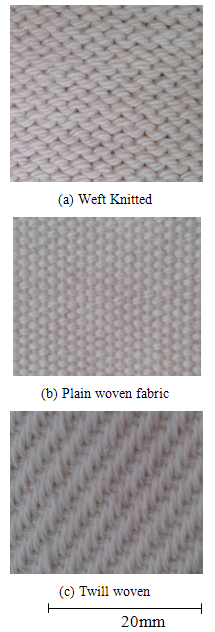 | Figure 1. Photographs of fabrics used for composite preparation |
3.1.1. Yarn and Fabric Parameters
- The parameters for the yarns and fabrics used for the purpose of this research work are shown in Table 1.
|
3.2. Tensile Properties of the Fabrics
- It can be seen that the tensile strength of all the fabrics increased by 4 - 30% after being treated for 60 seconds with 20% NaOH as shown in Figure 2. Tensile strength was highest for the plain fabric (13.67MPa) than twill (13.14MPa) and knitted fabrics (4.55MPa) when untreated, a trend also reported by Nassif [31] whose work was on the mechanical properties of micro polyester woven fabrics and also by Malik et al., [32] who investigated the Influence of plain and twill (3/1) weave designs on the tensile strength of PC blended fabrics. They found that plain fabric samples have considerable high tensile strength as compared to twill fabric samples at the same fabric counts. The superior strength of plain fabric over twill fabrics is unexpected because of high crimp associated with plain fabrics which leads to lower mechanical properties as reported by Saiman et al., [33] whose research was on the effect of fabric weave on tensile strength of woven kenaf reinforced unsaturated polyester composite.
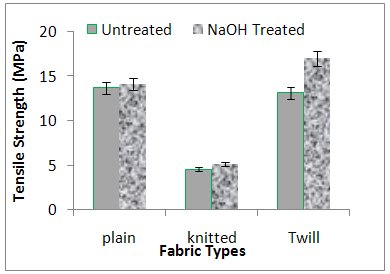 | Figure 2. Effect of alkali on the tensile strength of the fabrics |
 | Figure 3. Effect of alkali on the breaking elongation of the fabrics |
3.3. Tensile Properties of Composites
- From the results of tensile test shown in Figure 4, it is indicated that the maximum tensile strength for the composites occurred with twill fabrics for both the untreated and treated fabric samples with the knitted fabric having the least strength. The fabrics increased the strength by 32-81% with respect to the unsaturated polyester matrix showing the positive role of the cotton fabrics in the composite samples. With NaOH treatment, the tensile strength increased by 40-119% (Figure 5). Pothan et al., [17] conducted tensile and impact studies of woven sisal fabric-reinforced polyester composites prepared by RTM technique. In their study, both tensile and impact properties were found to be maximum for composites made with twill woven fabric. It can be said that the higher tensile strength of the composites with modified fabrics as compared to the untreated ones, may be due to the alkali which improves the adhesive characteristics of fabric surface by removing natural and artificial impurities thereby producing a rough surface topography [27]. This has increased the proportion of the effective surface area available for contact with the unsaturated polyester matrix polymer. Therefore, the composites were able to sustain higher loads before failure occurred compared to the neat unsaturated polyester matrix. Similar improvement in the tensile properties of alkali-treated natural fibers reinforced composites was reported by Yahaya et al., [38] who reported that treated woven kenaf improved tensile properties of composites.
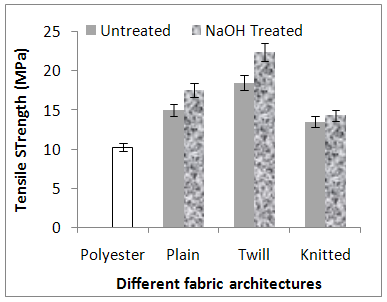 | Figure 4. Effect of alkali on the tensile strength of cotton fabric/UP composites |
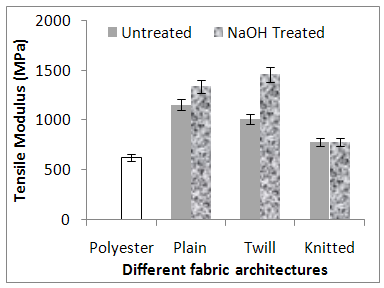 | Figure 5. Effect of alkali on the tensile modulus of cotton fabric/UP composites |
3.4. Flexural Properties of Composites
- The results show that coating cotton fabrics from plied yarn with polyester resin increased the flexural strength by 48 – 75% and the modulus by 13 – 51% with respect to the neat polyester composite. The alkali treated fabrics further improved the flexural strength and modulus by 93% and 65% respectively which can be considered to be high. Composites with twill and knitted fabrics recorded the highest and lowest strength and modulus respectively (Figures 6 and 7). This shows that cotton fabric-coated composite is stiffer and stronger than virgin unsaturated polyester.
 | Figure 6. Effect of alkali on the flexural strength of Cotton fabric/UP composites |
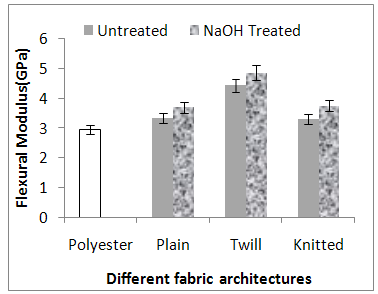 | Figure 7. Effect of alkali on the flexural modulus of Cotton fabric/UP composites |
3.5. Impact Properties
- It was found that fabric architecture and alkali treatment are crucial factors in determining the response of composite materials to impacting force. The impact strength of the unsaturated polyester was improved by about 76-93% when coated with the untreated fabrics for the various architectures. The alkali treatment further improved the impact strength by 86-104% (Figure 8). Composites with knitted fabrics recorded the highest impact strength of 33.8kJ/m2 and 35.8 kJ/m2 for the untreated and treated samples respectively. The performance of knitted fabrics as compared to woven fabric is better and they showed better impact resistance due to higher isotropic behavior.
 | Figure 8. Effect of alkali on the Impact strength of Cotton fabric/UP composites |
3.6. Hardness
- The inclusion of the cotton fabrics improved the Rockwell hardness of the polyester resin by about 2 - 22% for both the treated and untreated composites with respect to the neat polyester matrix (20.6 HRF). Composites with twill fabrics improved the hardness of the composites better than other architectures (25.2 HRF) as shown in Figure 9. The hardness of the knitted fabric composite was the least with a value of 21 HRF. The alkali treatment showed a positive effect on hardness. The variation in the hardness is caused by the difference in hardness between resin and fabric materials.
 | Figure 9. Effect of alkali on the hardness of Cotton fabric/UP composites |
3.7. SEM Analysis of Fractured Surface
- It can be observed from the Scanning Electron Micrograph of the fractured surfaces that matrix cracking occurred during the brittle failure (Figure 10a). Debonding and fiber pulled-out as the main fracture mode of composites was very visible (Figure 10b) thus, leading to voids. Composites coated twill fabrics showed more fiber pull out and voids than other fabrics. The composites with treated fabrics exhibited better interfacial bonding between the matrix and reinforcement (Figure 10b and 10c) compared to the untreated (Figure 10a) as evidenced by less cracking of the matrix before fracture.
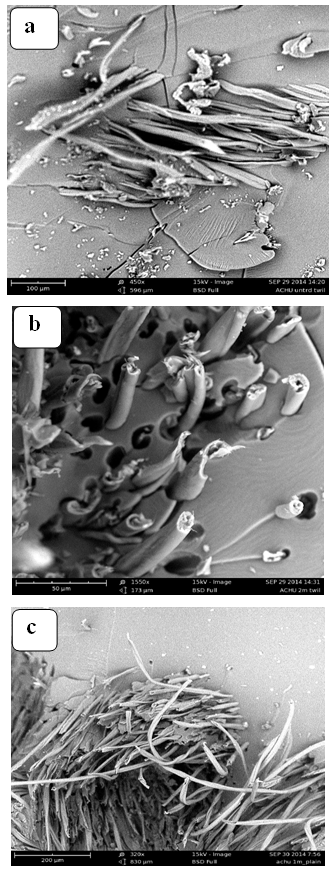 | Figure 10. SEM micrograph of the fractures composites (a) with untreated twill woven fabric (b) with treated twill fabric (c) with treated plain fabric |
4. Conclusions
- This work reported on the successful fabrication of cotton fabric-coated unsaturated polyester composites using plied yarns and the study of the effect of alkali treatment. The following conclusions can be drawn:The plied yarns used for the fabrics conferred significant reinforcement on the composites and has contributed significantly in resolving the problem of low mechanical properties and fiber pull out normally exhibited by cotton fiber composites. The study has demonstrated that woven and knitted cotton fabrics can function as reinforcement in textile composites.Alkali treatment has been found to improve mechanical properties of cotton fabric coated textile composites for the different architectures. The resistance to bending was best for composites coated with twill fabric as they are stiffer than plain and knitted fabrics, both when treated and untreated.Fabric architecture is an important factor in determining the response of composite materials to deformation. Composites coated with knitted fabrics have better response to impacting forces than other fabrics with good energy absorbing characteristics. Improvement in hardness for the various composites coated with this fabric is minimal (about 15% with respect to the uncoated).
ACKNOWLEDGEMENTS
- The authors are grateful to the management of Zaria Industries Limited for the supply of the plied yarns used for this research work.
 Abstract
Abstract Reference
Reference Full-Text PDF
Full-Text PDF Full-text HTML
Full-text HTML